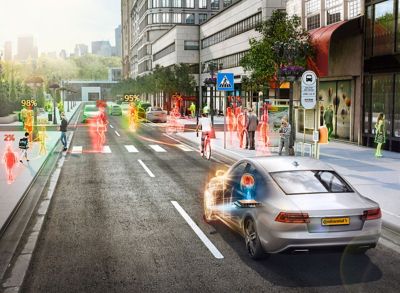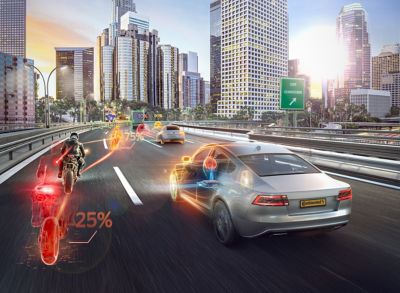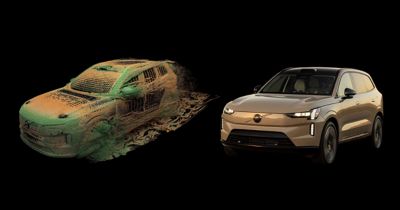-
United States -
United Kingdom -
India -
France -
Deutschland -
Italia -
日本 -
대한민국 -
中国 -
台灣
-
Ansys is committed to setting today's students up for success, by providing free simulation engineering software to students.
-
Ansys is committed to setting today's students up for success, by providing free simulation engineering software to students.
-
Ansys is committed to setting today's students up for success, by providing free simulation engineering software to students.
-
Contact Us -
Careers -
Students and Academic -
For United States and Canada
+1 844.462.6797

Probably the biggest trick to the adoption of full autonomy in the automotive space is learning how to safely achieve a level of perception that matches that of a human driver. Carmakers are rising to the challenge with a combination of advanced camera, radar, and lidar sensing technologies, machine learning, and artificial intelligence that makes self-driving possible. This includes the advanced driver-assistance system (ADAS) platforms already in play on our roadways, which are designed to assist drivers with safe vehicle operation.
However, the performance of these self-driving solutions is limited by unforeseen developments that lead to mechanical failure, including those impacting automotive radars. In this case, Ansys helps Continental AG cut through complexity during development to pinpoint the source of any negative effects like ghosting that impact radar function — and then implement solutions to quickly resolve them for customers.
Virtual Testing Clears Up Any System Misperceptions
Automotive radar relies on the projection of electromagnetic waves into the driving environment to detect objects in a vehicle’s path. When waves hit a target, some are absorbed as energy. Others bounce back to the vehicle, where that information is interpreted by a system of sensors responsible for detection, ranging, tracking, and sensing of nearby objects. This capability helps an ADAS and self-driving technologies interpret a given driving scene.
One particularly challenging phenomenon in automotive radar is ghosting. This happens when the path of the electromagnetic waves from a vehicle to an object is affected by ghost targets, or areas inside the vehicle chassis that create multipath reflections along the way.
Rather than leave the vehicle, some of these waves are reflected off these objects as input to the vehicle’s radar receiver. They are then incorrectly interpreted without ever reaching their intended target. The corrupted waveform then becomes the foundation for all subsequent signal processing, including machine learning and signal tracking, which compromises autonomous function.
While a correction might seem fairly straightforward, the origins of these multiple, indirect reflections between the target and the radar that lead to misperceptions are not easily pinpointed. For Continental, it takes Ansys HFSS high-frequency electromagnetic simulation software to accurately identify the exact location or root cause of these reflections, then determine the appropriate amount of absorber material needed to eliminate any unwanted signals.
“We leverage simulation to address various nuances after the radar is integrated inside the vehicle that contribute to ghost targets,” says Yadhu Krishnan M K, global co-lead of electromagnetic simulation at Continental. “Our vision is all about integrating simulation-driven design into our workflow so that it can accelerate our development process from design study to prototype, thus shortening our time to market and reducing our costs.”

Environmental perception based on sensorics like radar is essential for the realization of assisted and automated driving.
Ansys Helps Continental Take On Radar Complexity, Layer by Layer
The basic component in radar design is the antenna array, or radiating system composed of multiple connected antennas working together to send and receive radio waves. Continental engineers leverage HFSS software to optimize all the elements of these designs to reduce any manual work, including component prototyping and measurement. It’s a logical starting point to Yadhu’s approach to “go layer by layer to accurately address the inherent complexity involved.”
Once the radar design is completed with the help of HFSS software, the system is integrated into the vehicle behind the bumper. In one instance, it was determined that a secondary surface next to the radar was affecting the performance of the electromagnetic waves emanating from the radar. Here, the challenge was to understand how the performance of the radar was deteriorating due to the fascia, or decorative vehicle panels.
“Analysis becomes more complex when examining the mounting scenario, because now you also have to think about the influence of the chassis as well,” says Yadhu. “In this instance, electromagnetic waves encounter multiple reflections between the sensor, the fascia, and also the chassis, which lead to effects like wave scattering and ghost targets.”
To account for these discrepancies, the team must do some optimization. This may require varying the application of layers of paint on a bumper or adjusting sensor position to conform to the key performance indicators of the standards that the team has in mind.

Satellite radar for redundant 360-degree coverage of the vehicle’s surroundings
Simulation Cuts Through All the Cross Talk
Up until now, we’ve only been discussing the performance of one sensor. But in reality, there are lots of sensors and electronics in a vehicle, which introduces the possibility that they might communicate with each other. It’s a phenomenon known as cross talk, or electromagnetic interference. Ultimately, this activity can hamper radar performance.
“Radar integration is typically a complex environment in radar applications, as electromagnetic waves are prone to electromagnetic scattering due to reflections,” says Yadhu. “They’re the types of interactions that make a radio frequency engineer’s life difficult. Electromagnetic simulation is a window into understanding complex effects due to multipart reflections on a sensor, as well as the cross talk or electromagnetic interference happening between multiple sensors and electronics that interfere with vehicle perception.”
Then there’s the larger driving environment to consider. Cross talk can also occur between sensor systems as vehicles encounter each other on the road. To counter these types of interactions, Continental considers more dynamic scenarios like these with the help of Ansys AVxcelerate Sensors autonomous sensor simulation software.
Using AVxcelerate Sensors software, it’s possible to extend radar functionality testing to virtual test drives in a realistic environment to understand vehicle perception as a function of any additional effects. This enables Continental to consider radar performance not only related to cross talk but to obstacle detection and weather events, to name a couple. For example, the team can use the software to understand how a snow-covered bumper affects electromagnetic waves emanating from a vehicle’s radar.

One Comprehensive, Cloud-Based Workflow for All
This work culminated in the creation of an Ansys-powered toolchain, enabling Continental to quickly scale up to address perception challenges for customers in a high-performance computing (HPC) environment faster.
Running HFSS software on the cloud scaled well, enabling engineers at Continental to run large simulations with greater accuracy and speed. Simulations in this environment were at least 18 times faster than the previous tool they were using. Consequently, in decreasing overall simulation time, the team could complete projects much faster, thereby increasing productivity and finding efficiencies that resulted in a significant cost savings.
The team leverages a variety of computational resources to power Ansys simulations, including an on-premises single-node machine and an on-premises HPC cluster on the cloud, enabling the team to double its capacity when needed. As the complexity of its projects continues to grow, Continental anticipates scaling up cloud usage to meet these increasing demands.
These efforts are really paying off for Continental. The implementation of an Ansys toolchain for several hundred product lines across various projects will save automotive manufacturers in vehicle testing. The toolchain itself can also be further monetized as a simulation work product to help advance radar solutions.
Explore autonomous engineering solutions.
Just for you. We have some additional resources you may enjoy.
“We leverage simulation to address various nuances after the radar is integrated inside the vehicle that contribute to ghost targets. Our vision is all about integrating simulation-driven design into our workflow so that it can accelerate our development process from design study to prototype, thus shortening our time to market and reducing our costs.”
— Yadhu Krishnan M K, global co-lead of electromagnetic simulation, Continental
The Advantage Blog
The Ansys Advantage blog, featuring contributions from Ansys and other technology experts, keeps you updated on how Ansys simulation is powering innovation that drives human advancement.














